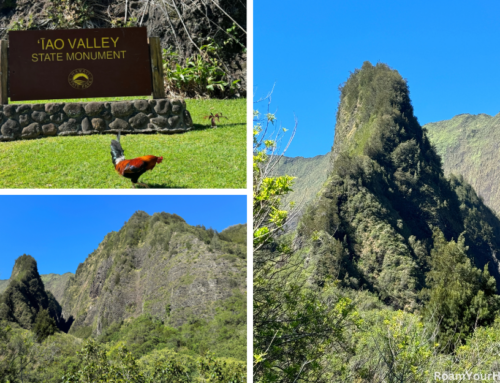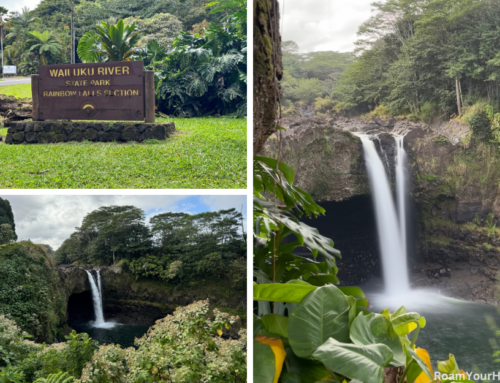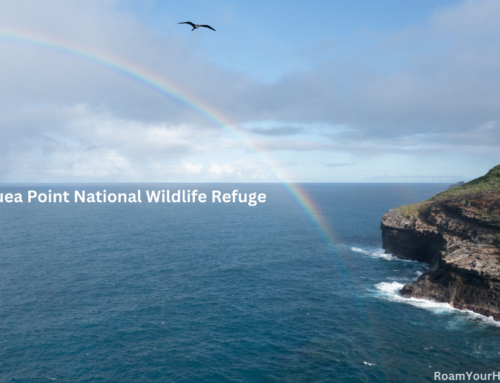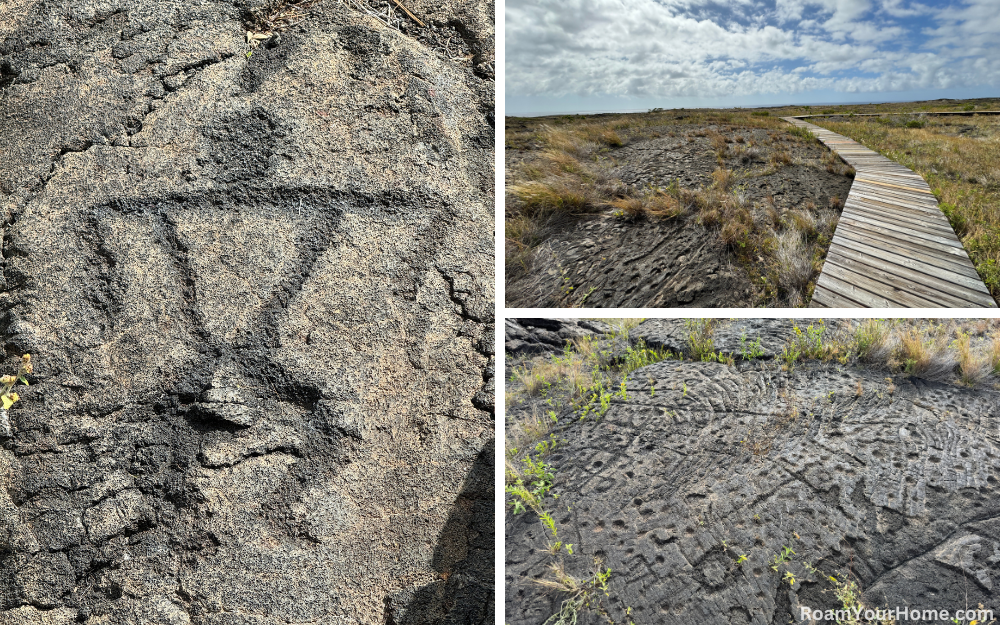
Pu‘uloa Petroglyphs: Hawaii Volcanoes National Park
The Pu‘uloa Petroglyphs are in Hawaii Volcanoes National Park. We pulled into the trailhead on a January afternoon. The dirt parking lot was not large—maybe there was room for 8 to 10 cars—but it was about half full that day. The trailhead is located at milepost 16.5 near the end of the Chain of Craters Road.
We’d taken our time on the drive there, checking out the sites along the way. Consequently, it was hot! The car thermostat read 92, but it certainly felt hotter than that stepping outside. After a good drink of water and a copious helping of sunscreen, we were on our way, but not before grabbing our extra-large Nalgene of water.
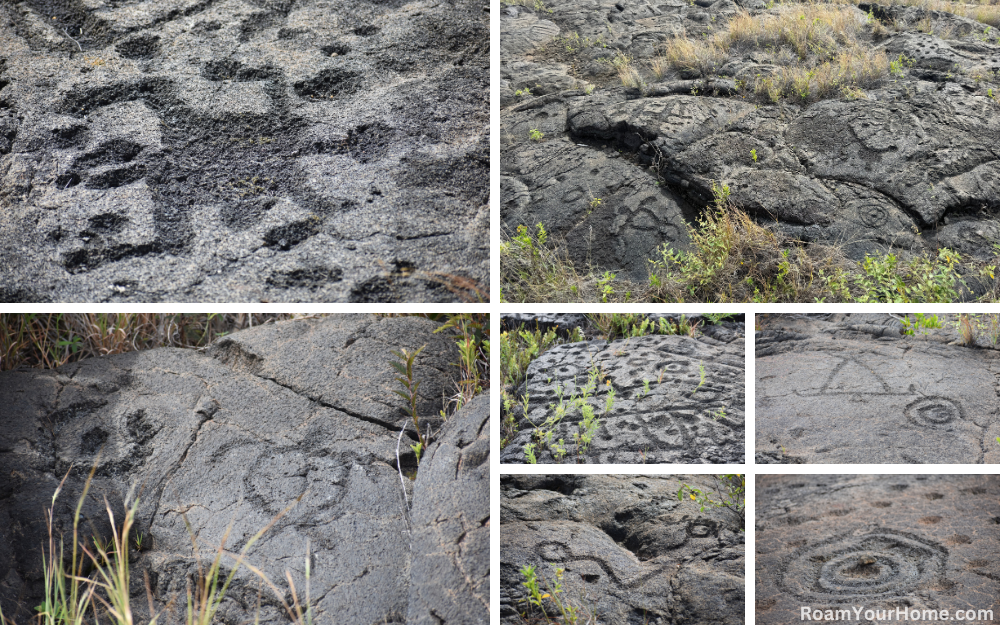
Hiking to the Pu‘uloa Petroglyphs
The hike starts across the road and is 1.4 miles out and back. The trail is well-worn across the lava, with some gentle ups and downs. As we worked our way down the trail, it felt like we were walking through an oven. “I need a drink of water,” I told my wife. The heat radiates off the black lava. “I know it’s so hot! We should be okay on water, though,” she responded.
After the short break, we quickly reached the boardwalk around the petroglyphs. “This is so much cooler than I expected,” I said excitedly. The boardwalk is elevated, and no doubt it has been put into place to protect the petroglyphs. It is also advantageous to view them, as being a little higher up gives a better view.
The boardwalk loops through the petroglyph field. I was stunned to learn that the area has more than 23,000 petroglyph images, the largest in Hawaii. The site is remarkably well-preserved. I could see dozens of human representations, canoe sails, and more, but most were shallow depressions or holes called puka.
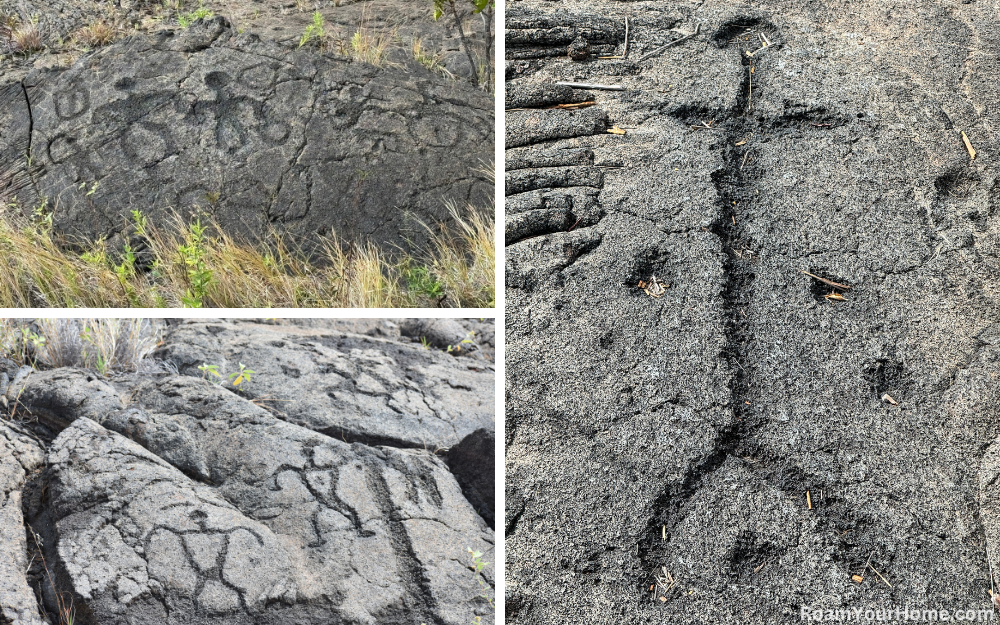
Petroglyphs are Sacred to Native Hawaiians
For many native Hawaiian ‘ohana (families), Puʻuloa is a revered and sacred site. To this day, families continue their traditions and ceremonial practices here to bless their children with a long life. In the native Hawaiian language, Puʻuloa translates to “long hill” or “Hill-(of)-long-(life)”
Families with ties to the land come to Pu’uloa to place their child’s piko or umbilical cord in the puka. They hope the Pu’uloa’s mana, or spiritual guiding energy, will bless that child with a long and prosperous life and root them in their ancestral lands.
Each puka, a little depression or hole, is created to house a single child’s umbilical cord. Of the over 23,000 petroglyphs here, about 16,000 are piko-related carvings. The design of each hole is as unique as the individual who created it. Some are carved deep, some shallow, and others extravagant, with multiple holes in a circle or lined up in a line.
Noted anthropologist Martha Beckwith visited Puʻuloa and made this observation:
“July 1, 1914. Rode out to Puuloa on the line between Kealakomo and Apuki. Here is a large pahoehoe mound used as a depository for the umbilical cord at the birth of a child. A hole is made in the hard crust, the cord is put in and as stone is placed over it. In the morning the cord has disappeared; there is no trace of it. This insures long life for the child. Mrs. Kama, born in 1862, was a native of Kamoamoa. Her mother brought her cord there. She had 15 children and for each one at birth the visit was made to Puuloa. Another mound, on the southern boundary of Apukiu., called Puumanawalea, was similarly used….Puuloa is especially rich. There are holes, pictures, initials chiseled into the rock.”
How long to visit Puʻuloa Petroglyphs?
We spent about 30 minutes walking around the boardwalk a couple of times. There was so much to see! The entire hike took about an hour and a half and was well worth it. I’ve visited many petroglyph sites, and I can confidently say that this was one of the coolest, best preserved, and frankly just interesting ones.
Where are the Puʻuloa Petroglyphs located?
The Puʻuloa Petroglyphs are located in Hawaii Volcanoes National Park on the big island. The trailhead is located at Milepost 16.5 near the end of the Chain of Craters Road.

